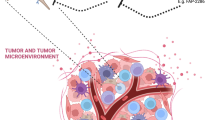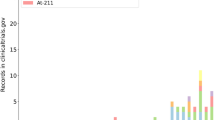Abstract
Purpose
We report on the biodistribution and internal radiation dosimetry in humans of [18F]fluciclovine, a synthetic L-leucine analogue being investigated as a potential diagnostic biomarker for neoplasia.
Methods
Whole-body positron emission tomography (PET) scans of 6 healthy volunteers were acquired at up to 16 time points up to about 5 h after a bolus administration of [18F]fluciclovine (153.8 ± 2.2 MBq). Venous blood samples were taken up to about 4 h post-injection from which 18F activity concentrations in whole blood and plasma were measured. Urine was collected as voided up to 4 h post-injection, from which the excreted 18F activity was measured. Absolute values of the 18F activity contained in up to 11 source regions (brain, salivary glands, lung, heart, pancreas, spleen, liver, red bone marrow, kidneys, uterus and urinary bladder contents) were determined directly from quantitative analysis of the images. For each source region, the 18F activity decay-corrected and normalised to that injected, as a function of time, was fit by an analytical function which was subsequently integrated to yield the cumulated activity normalised to the injected activity. These normalised cumulated activities were then used as input to the Organ Level INternal Dose Assessment/EXponential Modelling (OLINDA/EXM) package to calculate the internal radiation dosimetry of each subject following the Medical Internal Radiation Dose (MIRD) schema. An effective dose was then estimated for each subject.
Results
[18F]Fluciclovine was clinically well tolerated in this study. Very little 18F was excreted with only a mean value of 3.3 % present in the urine at about 4 h post-injection; no activity within the intestinal contents was noted. The highest mean initial uptakes were measured in the liver (13.8 %), red bone marrow (11.1 %) and lung (7.1 %). The highest mean radiation absorbed doses per unit administered activity were received by the pancreas (102.2 μGy/MBq), the cardiac wall (51.7 μGy/MBq) and the uterine wall (44.6 μGy/MBq). The mean effective dose per unit administered activity was 22.1 μSv/MBq.
Conclusion
The internal radiation dosimetry of [18F]fluciclovine appears acceptable for PET imaging.



Similar content being viewed by others
References
Jager PL, Vaalburg W, Pruim J, de Vries EG, Langen KJ, Piers DA. Radiolabeled amino acids: basic aspects and clinical applications in oncology. J Nucl Med 2001;42:432–45.
Grosu AL, Astner ST, Riedel E, Nieder C, Wiedenmann N, Heinemann F, et al. An interindividual comparison of O-(2-[18F]fluoroethyl)-L-tyrosine (FET)- and L-[methyl-11C]methionine (MET)-PET in patients with brain gliomas and metastases. Int J Radiat Oncol Biol Phys 2011;81:1049–58.
Glaudemans AWJM, Enting RH, Heesters MAAM, Dierckx RAJO, van Rheenen RWJ, Walenkamp AME, et al. Value of (11)C-methionine PET in imaging brain tumours and metastases. Eur J Nucl Med Mol Imaging 2013;40:615–35. doi:10.1007/s00259-012-2295-5. Accessed 6 Mar 2013.
Dunet V, Rossier C, Buck A, Stupp R, Prior JO. Performance of 18F-fluoro-ethyl-tyrosine (18F-FET) PET for the differential diagnosis of primary brain tumor: a systematic review and meta-analysis. J Nucl Med 2012;53:207–14.
Hong H, Zhang Y, Sun J, Cai W. Positron emission tomography imaging of prostate cancer. Amino Acids 2010;39:11–27.
Shoup TM, Olson J, Hoffman JM, et al. Synthesis and evaluation of [18F]-1-amino-3-fluorocyclobutane-1-carboxylic acid (FACBC): a PET tracer for tumor delineation. J Labelled Comp Radiopharm 1999;42:215–25.
Oka S, Hattori R, Kurosaki F, Toyama M, Williams LA, Yu W, et al. A preliminary study of anti-1-amino-3-18F-fluorocyclobutyl-1-carboxylic acid for the detection of prostate cancer. J Nucl Med 2007;48:46–55.
Schuster DM, Votaw JR, Nieh PT, Yu W, Nye JA, Master V, et al. Initial experience with the radiotracer anti-1-3-amino-3-18F-fluorocyclobutane-1-carboxylic acid with PET/CT in prostate carcinoma. J Nucl Med 2007;48:56–63.
Shoup TM, Olson J, Hoffman JM, Votaw J, Eshima D, Eshima L, et al. Synthesis and evaluation of [18F]-1-amino-3-flurocyclobutane-1-carboxylic acid to image brain tumors. J Nucl Med 1999;40:331–8.
Sörensen J, Owenius R, Lax M, Johansson S. Regional distribution and kinetics of [(18)F]fluciclovine (anti-[(18)F]FACBC), a tracer of amino acid transport, in subjects with primary prostate cancer. Eur J Nucl Med Mol Imaging 2013;40:394–402.
Nye JA, Schuster DM, Yu W, Camp VM, Goodman MM, Votaw JR. Biodistribution and radiation dosimetry of the synthetic nonmetabolized amino acid analogue anti-18F-FACBC in humans. J Nucl Med 2007;48:1017–20.
Asano Y, Inoue Y, Ikeda Y, Kikuchi K, Hara T, Taguchi C, et al. Phase I clinical study of NMK36: a new PET tracer with the synthetic amino acid analogue anti-[18F]FACBC. Ann Nucl Med 2011;25:414–8.
Akhurst T, Zanzonico P, Beattie B, Pillarsetty N, Finn R, Montiel J, et al. PET-based whole-body dosimetry of 18F-FACBC, a tumor-avid non-metabolized amino acid: initial results in patients. J Nucl Med 2006;47(Supp 1):492P.
McConathy J, Voll RJ, Yu W, Crowe RJ, Goodman MM. Improved synthesis of anti-[18F]FACBC: improved preparation of labeling precursor and automated radiosynthesis. Appl Radiat Isot 2003;58:657–66.
Hudson HM, Larkin R. Accelerated image reconstruction using ordered subsets of projection data. IEEE Trans Med Imaging 1994;13:601–9.
Sprague DR, Chin FT, Liow J-S, Fujita M, Burns HD, Hargreaves R, et al. Human biodistribution and radiation dosimetry of the tachykinin NK1 antagonist radioligand [18F]SPA-RQ: comparison of thin-slice, bisected, and 2-dimensional planar image analysis. J Nucl Med 2007;48:100–7.
McParland BJ. Nuclear medicine radiation dosimetry: advanced theoretical principles. Berlin: Springer; 2010.
International Commission on Radiological Protection. ICRP publication 70: Basic anatomical and physiological data for use in radiation protection: the skeleton. Oxford: Pergamon; 1995.
International Commission on Radiological Protection. ICRP publication 89: Basic anatomical and physiological data for use in radiological protection: reference values. Oxford: Pergamon; 2003.
Cloutier RJ, Smith SA, Watson EE, Snyder WS, Warner GG. Dose to the fetus from radionuclides in the bladder. Health Phys 1973;25:147–61.
International Commission on Radiological Protection. ICRP publication 56, part 2: Age-dependent doses to members of the general public from intake of radionuclides. Oxford: Pergamon; 1992.
Loevinger R, Budinger T, Watson E. MIRD primer for absorbed dose calculations. New York: Society of Nuclear Medicine; 1988.
Stabin MG, Sparks RB, Crowe E. OLINDA/EXM: the second-generation personal computer software for internal dose assessment in nuclear medicine. J Nucl Med 2005;46:1023–7.
Cristy M, Eckerman KF. Specific absorbed fractions of energy at various ages from internal photon sources. Volumes I – VII. Oak Ridge: Oak Ridge National Laboratory; 1987. Report No.: ORNL/TM-8381.
International Commission on Radiological Protection. ICRP publication 60: Recommendations of the international commission on radiological protection. Oxford: Pergamon; 1991.
International Commission on Radiological Protection. ICRP Publication 80, addendum to ICRP 53: Radiation dose to patients from radiopharmaceuticals. Ann ICRP 28 (3). Oxford: Pergamon; 1998.
International Commission on Radiological Protection. ICRP publication 106, addendum 3 to ICRP publication 53: Radiation dose to patients from radiopharmaceuticals. Oxford: Pergamon; 2007.
Stabin MG. MIRDOSE: personal computer software for internal dose assessment in nuclear medicine. J Nucl Med 1996;37:538–46.
Halpern BS, Dahlborn M, Quon A, Schiepers C, Walderr C, Silverman DH, et al. Impact of body weight and emission scan duration on PET/CT image quality and lesion detectability. J Nucl Med 2004;45:797–801.
Stabin MG, Siegel JA. Physical models and dose factors for use in internal dose assessment. Health Phys 2003;85:294–310.
Conflicts of interest
This study was sponsored by GE Healthcare. BJMcP is an employee of GE Healthcare.
Author information
Authors and Affiliations
Corresponding author
Rights and permissions
About this article
Cite this article
McParland, B.J., Wall, A., Johansson, S. et al. The clinical safety, biodistribution and internal radiation dosimetry of [18F]fluciclovine in healthy adult volunteers. Eur J Nucl Med Mol Imaging 40, 1256–1264 (2013). https://doi.org/10.1007/s00259-013-2403-1
Received:
Accepted:
Published:
Issue Date:
DOI: https://doi.org/10.1007/s00259-013-2403-1




